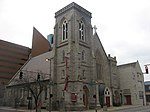Lucas County Courthouse and Jail
1897 establishments in OhioBuildings and structures in Toledo, OhioCounty courthouses in OhioCourthouses on the National Register of Historic Places in OhioGovernment buildings completed in 1897 ... and 4 more
Jails in OhioJails on the National Register of Historic Places in OhioNational Register of Historic Places in Lucas County, OhioNorthwest Ohio Registered Historic Place stubs

The Lucas County Courthouse is an architecturally-significant courthouse in downtown Toledo, Ohio, located at 700 Adams Street. The courthouse first opened in 1897. It was designed by David L. Stine, and the contractors were Dun, Perley & Co.The courthouse was added to the National Register of Historic Places in 1973.
Excerpt from the Wikipedia article Lucas County Courthouse and Jail (License: CC BY-SA 3.0, Authors, Images).Lucas County Courthouse and Jail
Adams Street, Toledo
Geographical coordinates (GPS) Address External links Nearby Places Show on map
Geographical coordinates (GPS)
| Latitude | Longitude |
|---|---|
| N 41.655277777778 ° | E -83.537222222222 ° |
Address
Lucas County Courthouse
Adams Street 700
43624 Toledo
Ohio, United States
Open on Google Maps










